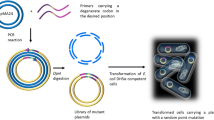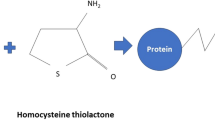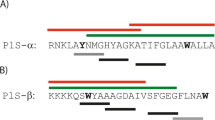Abstract
To study the role of the hinge region in nisin and to obtain mutants that exhibit altered or new biological activities and functional properties, we changed certain amino acids in the hinge region by performing site-directed mutagenesis with the nisinZ structural gene (nisZ). The results showed that the nisinZ mutants had decreased antimicrobial activities against Micrococcus flavus NCIB8166 and Streptococcus thermophilus. Interestingly, compared with wild nisinZ, mutant N20K nisinZ and M21K nisinZ displayed antimicrobial activity against gram-negative Shigella, Pseudomonas and Salmonella; and they had a higher solubility than wild-type nisinZ. At pH 8, the solubilities of N20K nisinZ and M21K nisinZ were, respectively, three-fold higher and five-fold higher than that of nisinZ. Mutant N20Q nisinZ and M21G nisinZ were considerably more stable than nisinZ at higher temperatures and neutral or alkaline pH. These mutants provided information that the central hinge region in nisinZ plays an important role in providing the conformational flexibility required for the antimicrobial activity on the membrane. Our finding documented that it may well be worth considering the construction of the new nisin mutants with changed inhibitory activity against a wide range of gram-negative bacteria and the improvement of functional properties by site-directed mutagenesis.






Similar content being viewed by others
References
Breukink E, Kraaij CV, Demel RA, Siezen R J, Kuipers OP, Kruijff B de (1997) The C-terminal region of nisin is responsible for the initial interaction of nisin with the target membrane. Biochemistry 36:6968–6976
Cabo ML, Pastoriza L, Sampedro G, González MP, Murado MA (2001) Joint effect of nisin, CO2, and EDTA on the survival of Pseudomonas aeruginosa and Enterococcus faecium in a food model system. J Food Prot 64:1943–1948
Cerrutti P, Terebiznik MR, De Huergo MS, Jagus R, Pilosof AMR (2001) Combined effect of water activity and pH on the inhibition of Escherichia coli by nisin. J Food Prot 64:1510–1514
Chen XZh, Hu HJ, Jia SF, Huan LD (2000) Construction of genomic library from L. lactis AL2 and isolation of entire nisin biosynthesis gene cluster. Acta Microbiol Sin 40:465–469
Chen XZh, Hu HJ, Yang W, Huan LD (2001) Cloning and expression of nisZ gene in Lactococcus lactis. Acta Genet Sin 28:285–290
Deng WP, Nickoloff JA (1992) Site-directed mutagenesis of virtually any plasmid by eliminating a unique site. Anal Biochem 200:81–88
Gasson MJ (1983) α,β-Unsaturated and related amino acids in peptides and proteins. In: Friedman M (ed) Protein crosslinking, nutritional and medical consequences. Plenum, New York, pp 131–153
Héchard Y, Sahl HG (2002) Mode of action of modified and unmodified bacteriocins from gram-positive bacteria. Biochimie 84:545–557
Hsu ST, Breukink E, De Kruijff B, Kaptein R, Bonvin AM, Nuland NA van (2002) Mapping the targeted membrane pore formation mechanism by solution NMR: the nisinZ and lipid II interaction in SDS micelles. Biochemistry 41:7670–7676
Huang WM, Zhang ZL, Han XJ, Wang JG, Tang JJ, Dong SJ, Wang EK (2002) Concentration-dependent behavior of nisin interaction with supported bilayer lipid membrane. Biophys Chem 99:271–279
Kuipers OP, Rollema HS, Yap WM, Boot HJ, Siezen RJ, De Vos WM (1992) Engineering dehydrated amino acid residues in the antimicrobial peptide nisin. J Biol Chem 267:24340–24346
Kuipers OP, Beerthuyzen MM, Siezen RJ, De Vos WM (1993) Characterization of the nisin gene cluster nisABTCIPR of Lactococcus lactis. Eur J Biochem 216:281–291
Lindström M, Mokkila M, Skyttä E, Hyytia-Trees E, Lähteenmäki L, Hielm S, Ahvenainen R, Korkeala H (2001) Inhibition of growth of nonproteolytic Clostridium botulinum type B in sous vide cooked meat products is achieved by using thermal processing but not nisin. J Food Prot 64:838–844
Liu W, Hansen JN (1990) Some chemical and physical properties of nisin, a small-protein antibiotic produced by Lactococcus lactis. Appl Environ Microbiol 56:2551–2558
Liu W, Hansen JN (1992) Enhancement of the chemical and antimicrobial properties of subtilin by site-directed mutagenesis. J Biol Chem 267:25078–25085
McAuliffe O, Ross RP, Hill C (2001) Lantibiotics: structure, biosynthesis and mode of action. FEMS Microbiol Rev 25:285–308
Mulders JW, Boerrigter IJ, Rollema HS, Siezen RJ, De Vos WM (1991) Identification and characterization of the lantibiotic nisinZ, a natural nisin variant. Eur J Biochem 201:581–584
Ottenwälder B, Kupke T, Brecht S, Gnau V, Metzger J, Jung G, Götz F (1995) Isolation and characterization of genetically engineered gallidermin and epidermin analogs. Appl Environ Microbiol 61:3894–3903
Perry AM, Ton-That H, Mazmanian SK, Schneewind O (2002) Anchoring of surface proteins to the cell wall of Staphylococcus aureus. III. Lipid II is an in vivo peptidoglycan substrate for sortase-catalyzed surface protein anchoring. J Biol Chem 277:16241–16248
Rollema HS, Kuipers OP, Both P, De Vos WM, Siezen RJ (1995) Improvement of solubility and stability of the antimicrobial peptide nisin by protein engineering. Appl Environ Microbiol 61:2873–2878
Sambrook J, Fritsch EF, Maniatis T (1989) Molecular cloning: a laboratory handbook, 2nd edn. Cold Spring Harbor Laboratory, Cold Spring Harbor, N.Y.
Schnell N, Entian KD, Schneider U, Götz F, Zähner H, Kellner R, Jing G (1988) Prepeptide sequence of epidermin, a ribosomally synthesized antibiotic with four sulphide-rings. Nature 333:276–278
Stevens KA, Sheldon BW, Klapes NA, Klaenhammer TR (1991) Nisin treatment for the inactivation of Salmonella species and other gram-negative bacteria. Appl Environ Microbiol 57:3613–3615
Terebiznik M, Jagus R, Cerrutti P, Huergo MS de, Pilosof AMR (2002) Inactivation of Escherichia coli by a combination of nisin, pulsed electric fields, and water activity reduction by sodium chloride. J Food Prot 65:1253–1258
Terzaghi BE, Sandine WE (1975) Improved medium for lactic streptococci and their bacteriophage. J Appl Microbiol 29:807–813
Van Den Hooven HW, Fogolari F, Rollema HS, Konings RN, Hilbers CW, Van De Ven FJ (1993) NMR and circular dichroism studies of the lantibiotic nisin in non-aqueous environments. FEBS Lett 319:189–194
Van Den Hooven HW, Doeland CC, Van De Kamp M, Konings RN, Hilbers CW, Van De Ven FJ (1996) Three-dimensional structure of the lantibiotic nisin in the presence of membrane-mimetic micelles of dodecylphosphocholine and sodium dodecylsulphate. Eur J Biochem 235:382–393
Van Den Ven FJ, Van Den Hooven HW, Konings RN, Hilbers CW (1991) NMR studies of lantibiotics. The structure of nisin in aqueous solution. Eur J Biochem 202:1181–1188
Van Heusden HE, De Kruijff B, Breukink E (2002) Lipid II induces a transmembrane orientation of the pore-forming peptide lantibiotic nisin. Biochem 41:12171–12178
Van Kraaij C, Breukink E, Rollema HS, Siezen RJ, Demel RA, De Kruijff B, Kuipers OP (1997) Influence of charge differences in the C-terminal part of nisin on antimicrobial activity and signaling capacity. Eur J Biochem 247:114–120
Vos P, Simons G, Siezen RJ, De Vos WM (1989) Primary structure and organization of the gene for a procaryotic, cell envelope-located serine proteinase. J Biol Chem 264:13579–13585
Wiedemann I, Breukink E, Kraaij C van, Kuipers OP, Bierbaum G, Kruijff B de, Sahl HG (2001) Specific binding of nisin to the peptidoglycan precursor lipid II combines pore formation and inhibition of cell wall biosynthesis for potent antibiotic activity. J Biol Chem 276:1772–1779
Acknowledgements
This work was supported by the tenth State Science and Technology Five-Year Key Program (2001BA708B05-07) and the Innovation Foundation of the Chinese Academy of Sciences. The authors wish to thank the anonymous referees for their helpful suggestions. We declare that the experiments comply with the current laws of China.
Author information
Authors and Affiliations
Corresponding author
Rights and permissions
About this article
Cite this article
Yuan, J., Zhang, ZZ., Chen, XZ. et al. Site-directed mutagenesis of the hinge region of nisinZ and properties of nisinZ mutants. Appl Microbiol Biotechnol 64, 806–815 (2004). https://doi.org/10.1007/s00253-004-1599-1
Received:
Revised:
Accepted:
Published:
Issue Date:
DOI: https://doi.org/10.1007/s00253-004-1599-1




